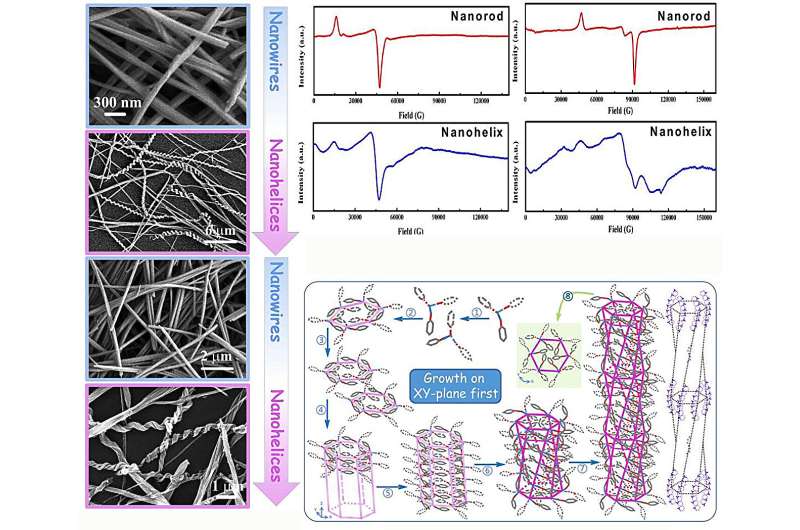
Reversible nanohelix transformation is one of the most exquisite and important phenomena in nature. Nanomaterials rarely form helical crystals. Due to the irreversibility of the twisting forces studied so far, untwisting is more difficult than retwisting crystalline nanohelices. Therefore, many reversible twist transformations between two stable crystalline products are rare and require a sensitive energy balance. This reversible transformation of nanohelices has long been considered difficult to achieve.
Researchers from the Hefei Institutes of Physical Science of the Chinese Academy of Sciences, in collaboration with researchers from Nanjing University and the University of Science and Technology of China, have discovered a subtle competition and cooperation relationship within the crystal structure, establishing a delicate energy balance between the structures of the twisted and untwisted crystalline nanohelices.
For the first time, the researchers have achieved multiple reversible transformations between nanowires and nanohelices. The study was published in Nature Communications.
Using electron spin resonance (ESR), including high-field ESR, at the Steady-State High Magnetic Field Experimental Facility, the researchers demonstrated changes in the coordination environment of Co(II) and a decrease in symmetry of the nanohelix. Solid-state nuclear magnetic resonance spectroscopy and terahertz spectroscopy revealed that π-π interactions play a crucial role in the helical growth.
These results, combined with theoretical calculations and various validation experiments, suggest that the twist arises from the competitive interaction between condensation reactions and π-π stacking processes. This unique competitive growth mechanism, together with the micro-adjustability of the growth mode, is the key to constructing finely adjustable energy balance systems and achieving reversible helical transformations.
By selectively designing and modifying the intermolecular forces and finely controlling the growth rates in different directions while maintaining the overall structure, the direction of energy balance can be changed, realizing the twisting, untwisting, and retwisting of nanohelices.
This study presents a new approach to design reversible crystal transformations by fine-tuning intermolecular interactions to enable multiple reversible transformations in crystals. This technique offers a new perspective for crystallography, improves crystallographic theory, and enables the realization of various complex reversible processes.
More information:
Wei Du et al, Twisting, untwisting, and retwisting of elastic Co-based nanohelices, Nature Communications (2023). DOI: 10.1038/s41467-023-40001-w
Journal information:Nature Communications
Provided by
Chinese Academy of Sciences

READ MORE
Can scientists clone dinosaurs?
Right now, the closest people can get to realistic dinosaurs are movie screens, fossils and [...]
Gate induced room-temperature magnetic phase transition realized in van der Waals ferromagnet nanoflakes
An illustration of device. Credit: Zheng Guolin By intercalating protons into van der Waals ferromagnet [...]
Size and shape of inhaled asbestos nanofibers may be exclusively responsible for pulmonary fibrosis
Pseudo-colored scanning electron microscopy image: phagocytosis by a macrophage (red) of glass nanofibers (blue) after [...]
A Model of the Cosmos
© matamu/Fotolia Sometimes it’s hard to get a handle on the vastness of the universe. [...]
DNA analysis spanning 9 generations of people reveals marriage practices of mysterious warrior culture
Researchers reconstructed the relationships among nearly 300 Avars, people from a 1,500-year-old mysterious warrior culture [...]
What Fossil Plants Reveal About Climate Change
Fossil plants reveal information about the temperature and precipitation of past climates. Scientists use what [...]
Nigiri vs Sashimi: Unveiling the Distinctions in Japanese Cuisine
Sashimi and Nigiri are popular in Japanese cuisine, nigiri tends to be more common in [...]
How Much of the Ocean Has Been Explored? Shockingly Little!
Although we’ve come a long way with space exploration, we have a long way to [...]